How to root and plant a rose stalk correctly?
Roses decorate the garden from late spring to late autumn. You just need to choose the right varieties for growing. You can get a bush of a rose you like from one cutting, a cut flower with a long stem.
Content:
- Types of roses for rooting
- Growing roses under banks
- Cutting roses from a bouquet
- Rooting in root crops
- other methods
- Growing errors
Types of roses for rooting
The main types of roses:
- Hybrid tea - medium size, with huge fragrant flowers.
- Ground cover - low creeping shrubs, covering an area of several square meters.
- Park - tall, with smooth long trunks, decorated with large flowers or bouquets
- Climbing - high, covered with a huge number of flowers, requiring support.
- Miniature - short, with charming small flowers, collected in bouquets.
From the above list, it can be seen that roses can be used to decorate almost any part of the yard or garden. Usually roses are bought with ready-made roots, sometimes even with flowers. The second method guarantees the conformity of the variety, but the bush will take root worse. When buying in the spring, there is a better chance of getting a healthy shrub, but the variety may not be what you expected.
A good way to get your favorite rose variety is to grow it from a cuttings.
Such bushes quickly adapt to climatic conditions, do not let the wild growth, characteristic of bushes grown on pods. Varieties with red flowers take root better. Whites take root a little worse. The lowest percentage of rooting of yellow roses. The overall probability of rooting for all varieties is 80%.
To increase the chance of getting a rose of the desired color, it is better to take more cuttings. There are such rooting methods:
- Under the bottles
- In root crops
- In the newspaper
- In the package
Growing roses under banks
Freshly cut roses, or those that were cut yesterday, take root better. These can be both shoots cut directly from the bushes, and flowers from a bouquet. Choose healthy thick branches, the leaves on which have not wilted. They should be semi-lignified, faded or before flowering.
Landing features:
- Cut the cuttings 15-20 cm long. They should have 2-3 buds (leaves). Under the bottom of them, a cut is made at an angle of 45 °. Work is carried out with a sharp, clean knife. From above, the cut is made straight, stepping back 2 cm. The leaves are cut off completely or shortened, leaving a third of the length. The lower cut is split to a depth of 5 mm. Two perpendicular cuts can be made. They will promote faster callus formation.
- Install the prepared cuttings in a jar of water, in which honey was previously dissolved at the rate of 1/2 teaspoon per glass. Honey is a natural growth promoter. You can take any root former purchased at a flower shop (Kornevin). Pieces of cut leaves are thrown into the jar. Withstand at least 10 hours.
- You can plant twigs in flower pots or directly into the ground. The soil for roses is poured into the flowerpots, to which a little local soil is added. In the garden, sand is added to the soil.
- Regardless of the planting site, the cuttings are immersed in the ground so that only one bud is above its surface. They are positioned at an angle of 40-50 °.
- Moisten the earth, cover with a glass jar or a cut-necked plastic bottle.
Such bottles are used for rooting, pouring soil into them and setting cuttings. This method is best used with a large number of cuttings. You can cover them with a general plastic wrap, creating a mini-greenhouse.
Cutting roses from a bouquet
The process is complicated by the fact that flowers are often treated with preservatives before being sold:
- Cut the cuttings 15-30 cm. Set in a bowl with water. Keep until such time as callus forms at the ends and roots sprout. They are transplanted into pots, covered with jars for several weeks.
- Set up the pots in a well-lit place. If the roses are very hot, they can be transferred to a corner with diffused lighting. You can't transfer a rose in the garden, so you need to choose the right place for it right away. Roses love bright sunlight, but when rooting cuttings, when they do not have roots yet, and the shoots have already appeared, they can dry out. Therefore, they need light shading at lunchtime.
- The planted cuttings are watered, sprayed every day, removing the lid. The best temperature is 26 degrees during the day and 17 degrees at night. When shoots appear, the banks are removed for a while. This usually takes a month. Do not forget to cover, because they do not have a root system yet. Lengthen the periods without cover, then remove it altogether.
- Roses rooted in pots are taken outside and left in the garden until autumn, constantly watering and gradually adapting to external conditions. For the winter, they are brought into a room with a positive temperature. They are planted in the ground next spring.
Roses rooted on the street should grow by 30-40 cm by the end of summer, they may even release buds. They are immediately plucked, not allowing them to bloom. They hibernate in the same place, but covered with the same banks, straw, agrofibre. Sometimes they are dug up and hidden in the basement until spring.
Rooting in roots and newspaper
Potato has a large supply of moisture and nutrients. Cuttings are prepared in the same way as with other methods. Leaves and thorns are cut. The difference is that, after removing them from the water with a root former, they are inserted into medium-sized potatoes, the eyes are cut out of it in advance, otherwise the potato shoots will sprout and drown out the cutting:
- Prepare a landing site. If there are many cuttings, they dig a groove, cover it with sand. Set potatoes with cuttings in rows at an angle, sprinkle with a mixture of sand and earth. The distance between the cuttings in a row is 15 cm.
- Cover with banks. The further procedure is not much different from the previous method. Sprinkle with water, and once a week adding sugar to it (2 tsp per glass of water). Banks are removed after 2 weeks. A month after planting, the shelter is removed on cuttings with well-formed shoots.
The first two methods are most often used in spring or early summer. But what if a beautiful rose was presented in winter? To do this, use the method of germination in the newspaper (it gives a low percentage of rooting, approximately 50%. The method was named Burito):
- Cut the cuttings in the same way as usual. They should be as thick as possible, about 5 mm in diameter. Wrap them all together or separately in a newspaper. Moisten it under the tap so that it is wet, but does not come apart in your hands.
- Rolls with cuttings are placed in a plastic bag, but they are not tightly sealed. Fresh air should be supplied to the cuttings, but moisture from the newspaper should also come out for a long time. The room temperature should be low, up to 18 degrees.
- Periodically, not more than once a week, or even less often they glance at the cuttings. After about 3 weeks, white bloom or hardness will be visible on the lower sections. These are callus, root embryos. At this time, shoots will begin to sprout from the buds.
Such cuttings are taken out of paper, set in flowerpots, covered with a jar and continue to be looked after in the same way as with other growing methods. You can use this method in the summer, if there is no time to constantly look at the cuttings.
other methods
Cuttings can be germinated without newspaper, in one package. To do this, the branches prepared in the previously described way are placed in a plastic bag, having previously overlaid with moistened juice aloe andsphagnum moss... For one part of the juice, take 9 parts of water. The bag is tightly tied, hung in a bright place. Under the influence of heat and light, the water in the bag evaporates, forming a mist. High humidity and temperature contribute to the rapid rooting of cuttings. After a month, they are planted in the soil.
Trannoy's method is that the cuttings are harvested immediately after flowering.
Remove the flower and part of the stem with it 5-7 cm long. This method is not widespread due to the fact that the cuttings are cut, but not planted until its lower buds swell. They take all the nutrients from the leaves, and only then are they ready for rooting. This moment cannot be missed, you need to quickly plant the cuttings in the ground. Cut off the leaves, leaving the top two. Several pieces are planted per hole, since the survival rate is low.
Cover with tall jars or 5-liter bottles. Roses will hibernate under them. The soil between the cuttings is loosened, improving access to the roots of air. Water regularly. In the fall, there is no point in rooting the stalk in the ground. But it can be kept in good condition until spring by digging it into the ground. Before that, the leaves are cut. Before the onset of frost, the cuttings are covered so that they do not get wet during the thaw.
Growing errors
Sometimes the rooting of roses fails due to the fact that seemingly insignificant mistakes were made during the cultivation process:
- You cannot stick the cuttings into the ground with effort. It is better to first loosen the soil, make a hole, place a stalk in it, and then cover it with earth.
- At the bottom of the pot for growing roses from cuttings, a drainage layer must be laid, which will protect the soil from waterlogging, and the roots from decay.
- Covering the stalk with a jar, you need to make sure that the shoots do not touch its walls. This can lead to leaf rot. The volume of air in the can should be sufficient, so it is better to take more of it.
- It is necessary to water the cuttings in the area of the leaves, spray it with a drip method.
More information can be found in the video:





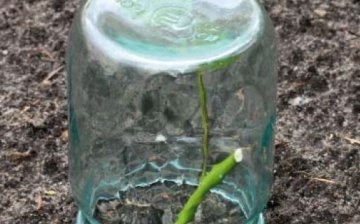

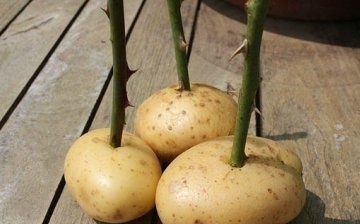
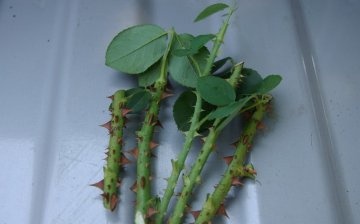









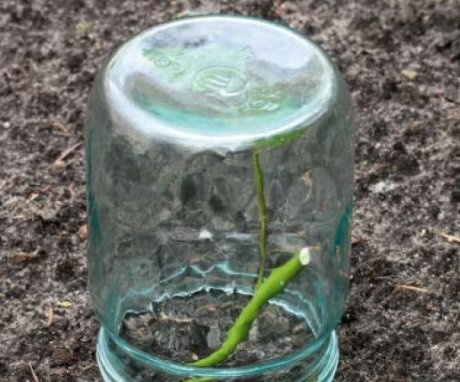
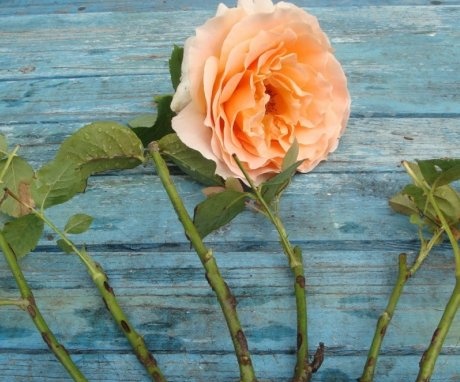
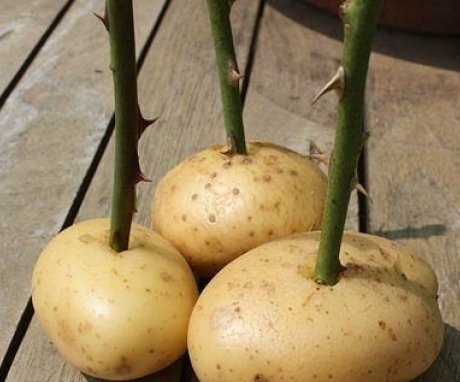
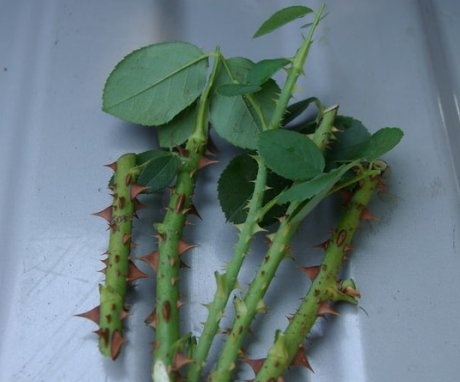
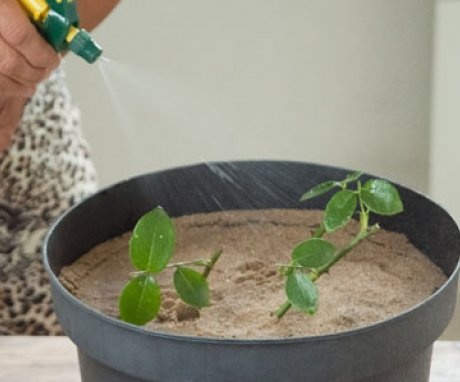
It seems that everything is so simple, but I did not manage to root the rose. But I really want to try again, especially since my friend looked at a very beautiful copy. Now I will try in potato tubers.
masmetall! I root roses for the garden, which are presented in bouquets. It turns out great and, most importantly, for free. And I root them in water, first for the appearance of roots, then planting them in peat pots with a special soil for roses. But I haven't tried it in potatoes :-)
I once planted a rose right at home in a bucket. I have grown such a huge bush. I was really happy. Here's one problem - for some reason he bloomed only once and more - nothing. Nobody will tell you - what could be the reason?
Dear Natalya Semyonovna! I also have roses that I root from bouquets sometimes bloom once and then most likely they are either pollinated with rose hips. for example, or not at all.
I tried to root two cuttings of a rose in winter. Most likely they were Dutch, well fed with fertilizers. We stood in the water for a long time. Young leaves from buds on the stem began to sprout. I planted the cuttings in the ground, covered with a jar. They did not take root, although there was hope. You only need to root the roses grown here.